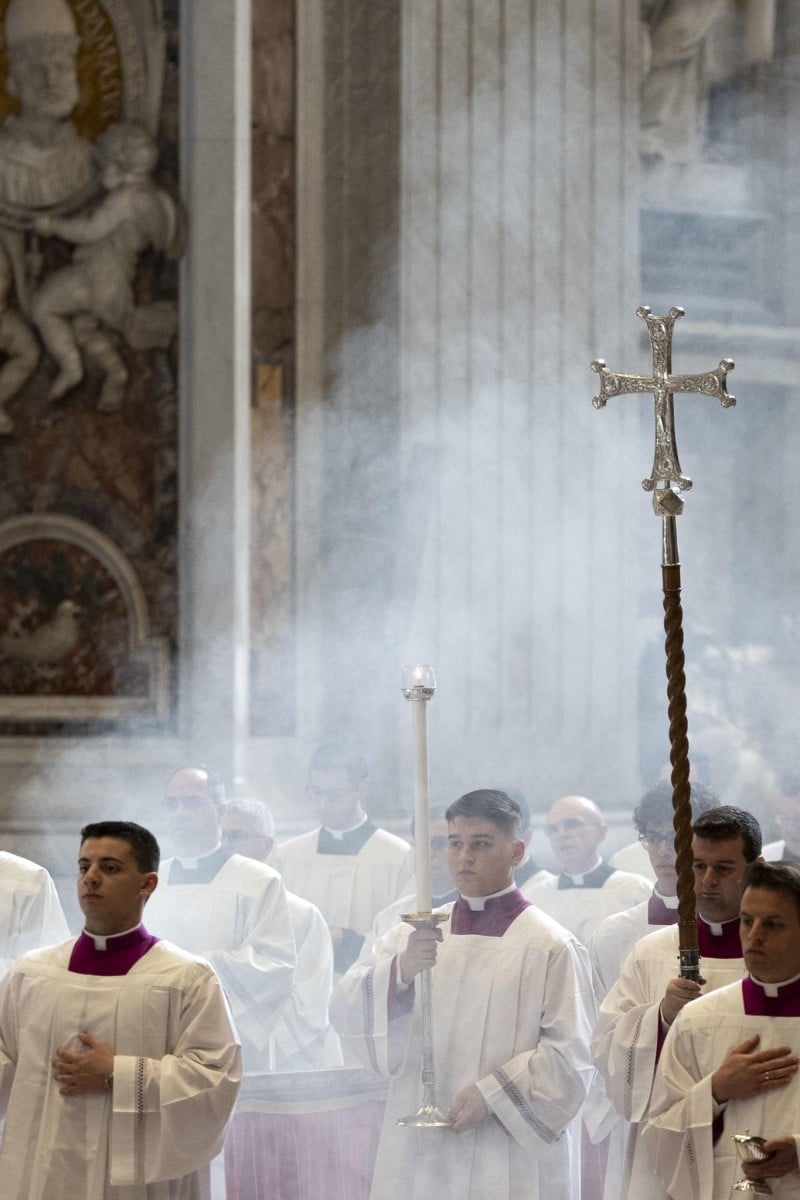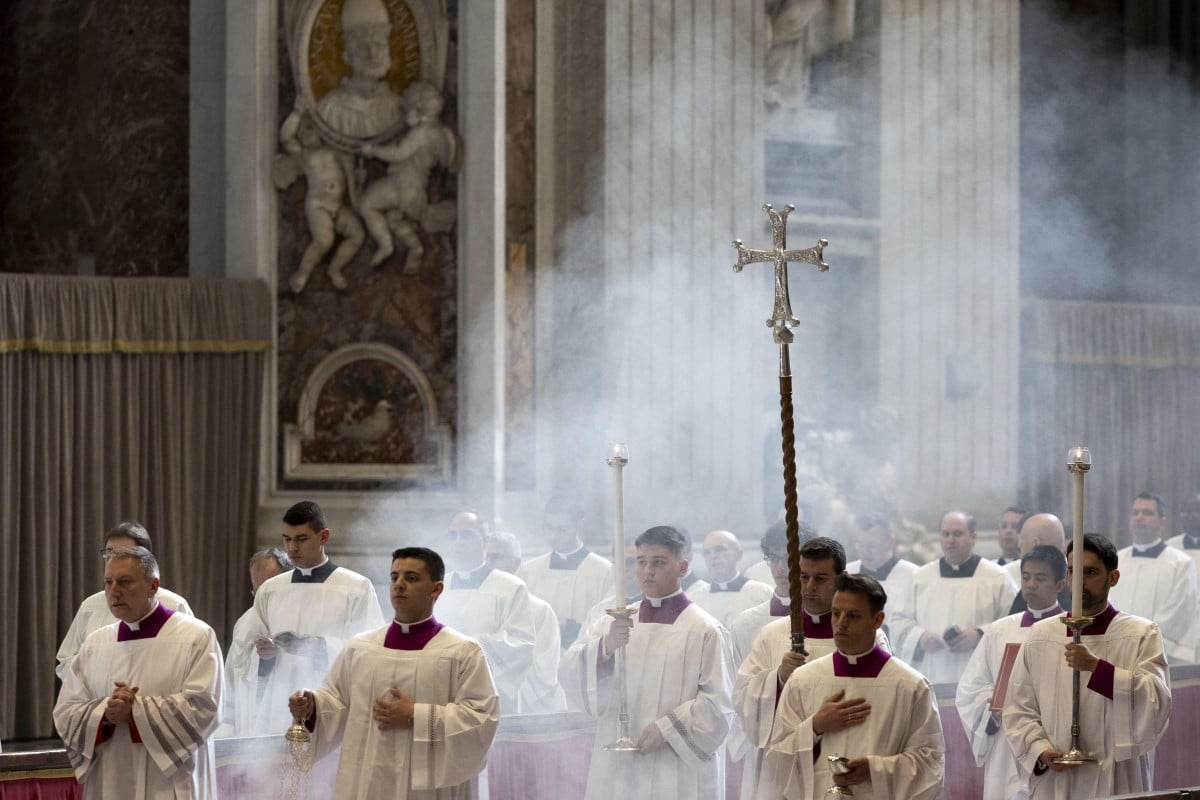
What happens after a pope dies? Explaining the rites, rituals, funeral and burial
The death of a pope sets in motion a series of rites and rituals which include a public display of the body, a funeral and a burial
 The procession with Pope Francis’s coffin enters St Peter’s Basilica where his body will lie in state, in Vatican City. Photo: EPA-EFE
The procession with Pope Francis’s coffin enters St Peter’s Basilica where his body will lie in state, in Vatican City. Photo: EPA-EFEWell before the conclave to elect a successor, the death of a pope sets off a series of carefully orchestrated rites and rituals, including the certification of death, public display of his body for the faithful to pay their respects, and a funeral and burial.
Pope Francis, who died on Monday, revised various rites last year, simplifying the funeral rituals to emphasise his role as a mere bishop and allowing for burial outside the Vatican in keeping with his wishes.
But the core elements remain, including the three key moments that must be observed between the death of a pope and his burial.
Pope Francis dies at 88: first Latin American pope advocated for peace and compassion
Why were changes to the funeral rites necessary?
While it is common for popes to adjust the rules regulating the conclave that elects their successor, there had not been a revision of the papal funeral rites since 2000.
The changes became necessary when Emeritus Pope Benedict XVI died on December 31, 2022, and the Vatican had to work out a funeral for the first retired pope in 600 years.
A few months later, Francis revealed he was working with the Vatican’s master of liturgical ceremonies, Archbishop Diego Ravelli, to overhaul and simplify the entire book of rites. Explaining the reforms, Ravelli said the changes aimed “to emphasise even more that the Roman Pontiff’s funeral is that of a pastor and disciple of Christ and not of a powerful man of this world”.
The three main stations – or moments – occur first in his home, then in St Peter’s Basilica and finally in the burial place. The reform allows the formal confirmation of death to occur in Francis’ personal chapel rather than his bedroom. The change may be due to practicality: Francis chose to live in a small suite in the Vatican’s Santa Marta hotel rather than the Apostolic Palace and has a personal chapel at Santa Marta.
The declaration of death
Upon the pope’s death, the head of the Vatican health service examines the body, establishes the cause of death and writes a report.
The body is dressed in white and rests in the pope’s personal chapel for the ritual pronouncement of death, presided over by the camerlengo, the Vatican official who runs the Holy See administration between the death or resignation of one pope and the election of another. The camerlengo is American Cardinal Kevin Farrell, one of Francis’ most trusted aides.
The rite no longer requires the body to be placed in the traditional three coffins made of cypress, lead and oak. Now, the pope’s body is placed in a wooden coffin with a zinc coffin inside. The pope is dressed in red liturgical vestments, his mitre – the traditional headdress of bishops – and the pallium woollen stole, a kind of scarf. The Pasqual candle, a large, decorated candle used at Easter, is placed nearby.
The camerlengo drafts the formal declaration of death, attaching the certificate prepared by the health service chief. The master of liturgical celebrations, Ravelli, then decides when other faithful can pay their respects before the coffin is moved to St Peter’s Basilica for public viewing.
In the basilica
When the body is brought into the basilica, the Litany of Saints chant is sung. The camerlengo leads the procession. Instead of placing the pope’s body on an elevated moving frame, the simplified wooden coffin will face the pews, with the Pasqual candle nearby.
The sealing of the coffin
The night before the funeral, the camerlengo presides over the closing and sealing of the coffin in the presence of other senior cardinals. A white cloth is placed over the pope’s face. A bag containing coins minted during his papacy is placed in the coffin along with a one-page written account of his papacy – known in Italian as a rogito, an official deed. It is read aloud by the master of liturgical ceremonies and then rolled up and slipped inside a cylindrical tube placed inside the coffin. Another copy is kept in the Vatican archives. The covers of both the zinc coffin and the wooden one bear a cross and the papal coat of arms.
Francis’ coat of arms, which he kept from when he was bishop, features a shield and the monogram of his Jesuit order, with the words miserando atque eligendo, Latin for “Having had mercy, he called him”. It comes from an episode in the Gospel where Christ picks a seemingly unworthy person to follow him.
The funeral and burial
The funeral is presided over by the dean of the College of Cardinals or, if that is not possible, by the vice dean or another senior cardinal. Various seals are impressed on the coffin before it is placed inside the tomb.
Francis’ reform allows for burial outside the Vatican and he had said he wants to be buried in the St Mary Major Basilica across town. His choice reflects his veneration of an icon of the Virgin Mary that is located there.